| | LRK Home | | Bio Info | | Krash Khronicles | | LAROKE | |
| | BettyLou | | BillyBob's Garage | | Rat Patrol | | Deerslayer | | Elvira | |
| | Land of the Free and Home of the Brave | |
| | Keppylou's Art | | WWI Soldier's Diary | |
Project Nailhead Log
![]()
DEERSLAYER LINKS including vendor sites for parts and tools as well as sites for old truck and hot rod organizations
![]()
TINKERING WITH DEERSLAYER chronicles the day-by-day maintenance and improvements episodes for Deerslayer, a '37 Chevy farm truck hot rod.
CRUISIN' WITH DEERSLAYER Roadtrips, cruise-in's and truck show stories and tall tales.
TONY'S DUNGEON Tony Pascarella's forum entries at OldGMCtrucks.com regarding Deerslayer, particularly the 302 GMC engine build in his farmhouse basement.
![]()
DEERSLAYER MAINTENANCE Ever changing detailing, oil change, lube, etc. maintenance routines specifically developed for Deerslayer, including required tools, materials and procedures.
PROJECT NAILHEAD Chronicles the rebuild of a 1954 Buick Roadmaster 322 nailhead engine as a future replacement for Deerslayer's Jimmy 302.
4. Painting
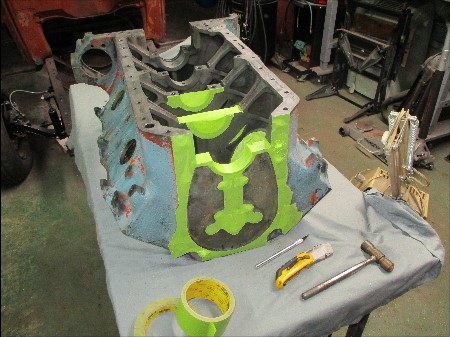 May
28th
2021 Cleaned up after the derusting operations and began
preparing
the nailhead block for painting. Plugged threaded holes and started
masking off
machined surfaces for the first stage of painting. My masking Kung Fu
is
not strong and it's tedjus work. I did use the trick of trimming the
masking tape at sharp edges by using a small brass ball-peen hammer to
make a cut line in the tape.
May
28th
2021 Cleaned up after the derusting operations and began
preparing
the nailhead block for painting. Plugged threaded holes and started
masking off
machined surfaces for the first stage of painting. My masking Kung Fu
is
not strong and it's tedjus work. I did use the trick of trimming the
masking tape at sharp edges by using a small brass ball-peen hammer to
make a cut line in the tape.
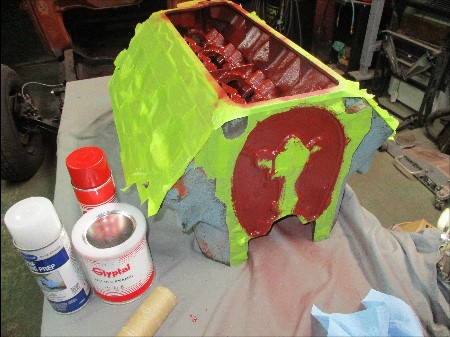 June
16th
2021Fellow HAMBer from Sweden, J.Hansen suggested using a file
in lieu of the brass hammer to trim the masking tape. Tried it and had
moderate success. It's a skill I have to hone some. Masked the rest of
the crankcase and turned the block right side up.
June
16th
2021Fellow HAMBer from Sweden, J.Hansen suggested using a file
in lieu of the brass hammer to trim the masking tape. Tried it and had
moderate success. It's a skill I have to hone some. Masked the rest of
the crankcase and turned the block right side up.
Used the old throw away juice lifters to mask the lifter bores. That saved some time. The cam bearings, not so much. Fingers are too big to get the masking tape in the confined space. Had to retreat for some deep ponder mode thinking.
Brought a paper towel roll tube back to the shop with me from the office. It was a smidgen greater diameter than the cam bearings. I was able to slit it and cut it into rings that masked the cam bearings nicely.
Cleaned some creeping flash rust with wire cup in Dremel tool
and
blew off with electric leaf blower. Gave it a few cycles of PRE Paint
Prep dosings followed by more leaf blower blow-offs.
Painted as much of the lifter valley with Glyptal red insulating enamel paint as I could reach by brush and finished up what I couldn't reach with spray-bomb.
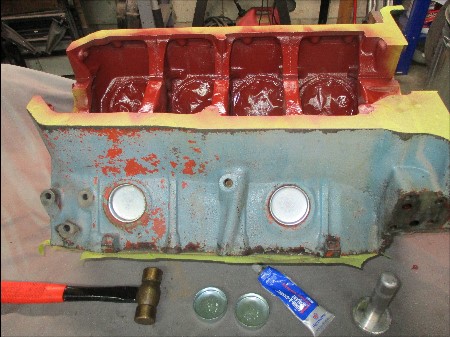 June
18th
2021 Flipped the nailhead block over tango uniform again and
painted the cathedral nave crankcase with Glyptal after the PRE
Paint
Prep treatment and repairing some of the masking dislocated by the
first flip.
June
18th
2021 Flipped the nailhead block over tango uniform again and
painted the cathedral nave crankcase with Glyptal after the PRE
Paint
Prep treatment and repairing some of the masking dislocated by the
first flip.
Installed new freeze plugs with Permatex Form-A-Gasket #1.
This operation is terra incognita to me and I buggered the first run at
it as I'm apt to do. It was a do over but by the time I installed the
fourth one, I was feeling semi-pro and a little cocky.
Ordered a pair of block drain petcocks. Started the second stage of masking for the nailhead green engine paint from Bill Hirsch. This involves sealing the block interior areas and trimming the masking tape using the gasket set as guide templates.
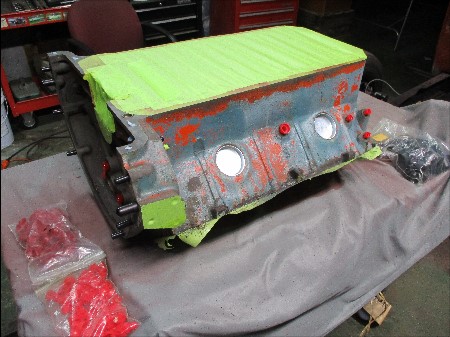 June
21st
2021 Got the bottom block masking in place and trimmed, then
came across three assortments of paint masking hole plugs I picked up
on an impulse buy in the last century. These plugs saved a lot of time
masking the numerous holes on the sides and back of the nailhead block.
June
21st
2021 Got the bottom block masking in place and trimmed, then
came across three assortments of paint masking hole plugs I picked up
on an impulse buy in the last century. These plugs saved a lot of time
masking the numerous holes on the sides and back of the nailhead block.
Gave the sides and back of the block the PRE Paint Prep treatment which led to a setback. The old Pontiac blue paint did not like the paint prep and started to flake off. I retired to the deep ponder mode chair.
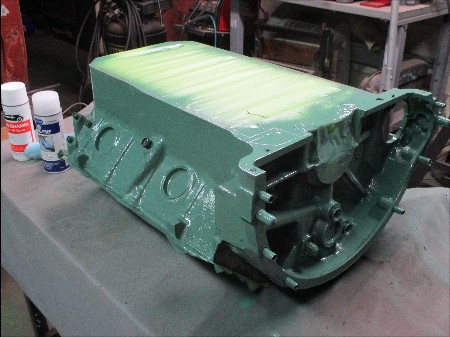 June
23rd
2021 Went over the block with scotchbrite cookies in the air
powered angle grinder to remove all the loose paint remnants,
blew it off with the air hose, then applied the PRE Paint Prep again.
This time, the surface remained stable and I followed up with two coats
of the Bill Hirsch Engine Enamel spray bomb.
The Buick nailhead green is an acquired taste. Some have nicknamed it
puke green. They also put these engines in medium duty Chevy trucks
from
1956 to 1959 when the Chevy 348 was introduced. I didn't research
Chevy's color for the 322 because I like the green.
June
23rd
2021 Went over the block with scotchbrite cookies in the air
powered angle grinder to remove all the loose paint remnants,
blew it off with the air hose, then applied the PRE Paint Prep again.
This time, the surface remained stable and I followed up with two coats
of the Bill Hirsch Engine Enamel spray bomb.
The Buick nailhead green is an acquired taste. Some have nicknamed it
puke green. They also put these engines in medium duty Chevy trucks
from
1956 to 1959 when the Chevy 348 was introduced. I didn't research
Chevy's color for the 322 because I like the green.
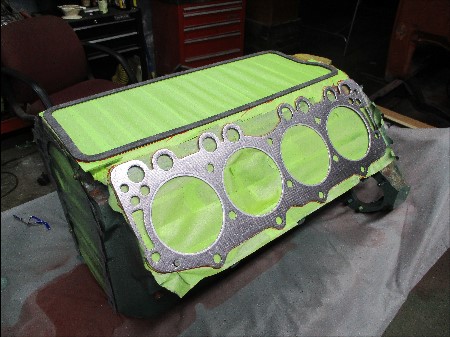 June
24th
2021 Flipped the block right side up again and finished
trimming the masking tape around the head and valley cover gaskets by
running a sharpie line around the gaskets and trimming just inside the
line with X-Acto knife.
June
24th
2021 Flipped the block right side up again and finished
trimming the masking tape around the head and valley cover gaskets by
running a sharpie line around the gaskets and trimming just inside the
line with X-Acto knife.
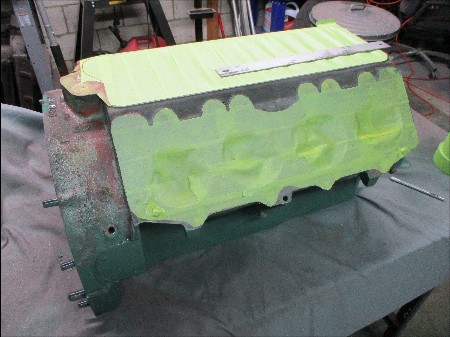 The paint
is still tacky. The weather, here in South Florida, is muggy this week.
After the top of the nailhead is painted and the masking comes off,
touch ups can be made at any time by spraying a few blasts of paint in
a cup and dabbing it on with a Q-Tip.
The paint
is still tacky. The weather, here in South Florida, is muggy this week.
After the top of the nailhead is painted and the masking comes off,
touch ups can be made at any time by spraying a few blasts of paint in
a cup and dabbing it on with a Q-Tip.
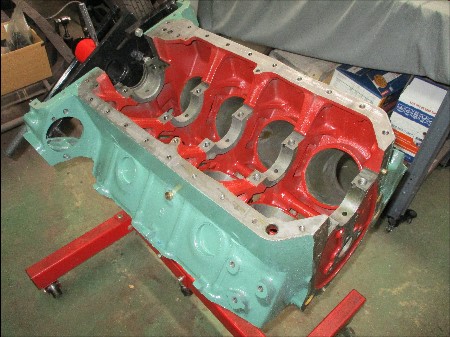 June
28th
2021 Plugged some more holes, PRE Paint Prepped and painted
the upper nailhead block surfaces with two coats. Let the paint cure
for a couple of days and mounted the block back on the engine stand.
Removed the masking, cleaned the machined surfaces and wiped them with
Marvel Mystery Oil.
June
28th
2021 Plugged some more holes, PRE Paint Prepped and painted
the upper nailhead block surfaces with two coats. Let the paint cure
for a couple of days and mounted the block back on the engine stand.
Removed the masking, cleaned the machined surfaces and wiped them with
Marvel Mystery Oil.
Matt Martin, of Centerville Auto Repair, commented about the block drain petcocks and I decided to go with his practice of using plugs. The petcocks will go in the parts box for radiator spares. I got 1/4" NPT brass plugs for the nailhead and installed them with Threadlocker blue.
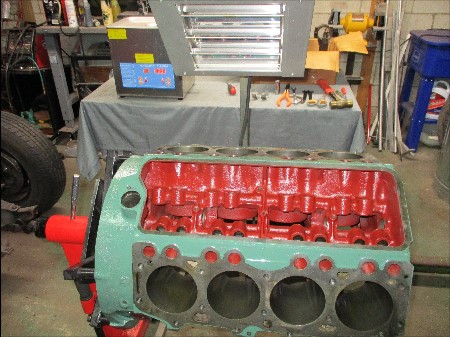 July
15th
2021 Moving along with the piston cleanup.
Meanwhile, the block paint has been curing for almost three weeks. Both
the Bill Hirsh engine paint and the Glyptal insulating paint will
benefit from heat treatment prior to running the engine. With that in
mind, I rooted around in the dark recesses of the BillyBob shop until I
found my Powder coating curing lamp. Went about setting the lamp up to
bake the Glyptal paint at about 260 degrees F for 2 hrs. This process
takes awhile as you have to move the engine block from time to time to
concentrate the infrared rays on different areas.
July
15th
2021 Moving along with the piston cleanup.
Meanwhile, the block paint has been curing for almost three weeks. Both
the Bill Hirsh engine paint and the Glyptal insulating paint will
benefit from heat treatment prior to running the engine. With that in
mind, I rooted around in the dark recesses of the BillyBob shop until I
found my Powder coating curing lamp. Went about setting the lamp up to
bake the Glyptal paint at about 260 degrees F for 2 hrs. This process
takes awhile as you have to move the engine block from time to time to
concentrate the infrared rays on different areas.
You can email me at ![]() webmaster@laroke.com
webmaster@laroke.com
Issued Wednesday February 15, 2012
Updated Friday July 16, 2021
copyright © 2012-2021 Larry Robert Kephart all rights reserved
| | LRK Home | | Bio Info | | Krash Khronicles | | LAROKE | |
| | BettyLou | | BillyBob's Garage | | Rat Patrol | | Deerslayer | | Elvira | |
| | Land of the Free and Home of the Brave | |
| | Keppylou's Art | | WWI Soldier's Diary | |